| |
Summary:
Comet McNaught swung by the Sun in mid-January
2007. Fierce solar heat turned it into the brightest comet in 40
years; for a few days it was actually visible in broad daylight!
When McNaught emerged from the sun's glare into the skies of the
Southern Hemisphere, the tail alone stopped traffic and was mistaken
for a brush fire, an explosion, a mysterious cloud and probably
many other things never reported. For photographers, it was the
photo-op of a lifetime. Now Comet NcNaught is receding into the
outer solar system never to return -- only the pictures remain. Enjoy
the gallery! |
 |
| |
| |
Photographer,
Location |
Images |
Comments |
|
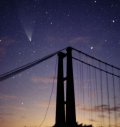
|
Ian Cooper,
Opiki, Manawatu, New Zealand
Feb. 6, 2007 |
#1,
#2, #3,
#4 |
The comet is
now around magnitude +3.6 (= to Beta Indi) and a tail of
20 degrees long fanning out to about 8 degrees wide at the
end. In the foreground is a derelict swing bridge across
the Manawatu River.
Photo
details: Nikon F with a 50mm lens @ f/2, Fuji 800
Press film, 1 minute exposures.
|
|
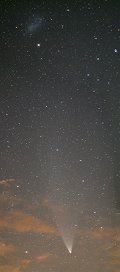
|
Noel
Munford,
Palmerston North, New Zealand
Feb. 6, 2007 |
#1,
#2 |
Without
a Moon, the comet was clearly visible to the unaided eye
and I noted it significantly brighter than 47 Tuc. It must
still be around 3rd mag.
Photo
details:
(#1)
Fujifilm
S3, ISO 1600, 2 x 30 seconds.
(#2)
Fujifilm
S3, 80mm
lens, f/1.8, ISO 1600, 30 seconds.
Note
the clear anti-tail in the 80mm shot. |
|

|
Chris
Picking,
Wairarapa, North Island, New Zealand
Feb. 5, 2007 |
#1,
#2, more |
Still
visible to the unaided eye. These images were taken just
before moon rise.
Photo
details: Canon
10D, 50mm
lens, f3.5, 3 minute exposures. |
|

|
James
Tse,
Christchurch, South Island, New Zealand
Feb. 4, 2007 |
#1,
#2, |
The
comet tail has lost its extensive streams and forms a triangular
shape which is only visible by a pair of 7x50
binoculars. The greenish displays an elliptical protuberance
in front of the comet head.
Photo
details:
(#1)
Canon
300D, Canon
EF 70-200 mm lens @ 70 mm, f/2.8, ISO 800, 30 sec.
(#2)
Canon
350D, Astro Physics 105 EDT Traveler + 0.75X Telecompressor,
400 ISO, 2 min
|
|

|
Shevill
Mathers,
Ralphs Bay, near Hobart, Tasmania
Feb. 2-3, 2007 |
#1,
#2, #3 |
Barely
visible to the naked eye, but a 30-second exposure showed
the comet nicely.
Photo
details: Nikon
D200 with a Nikkor
28mm lens (f/2.8) and a Nikkor
85mm lens (f/1.4), 30-second exposures at 350 ISO. I
used the faster lens for the close-up shot. |
|


|
Mendonca
Jr,
Pousada Caina - state of Parana - Brazil
Feb. 3, 2007 |
#1,
#2, #3 |
The
amazing Comet McNaught is still visible to the naked eye
on Feb. 3rd.
Photo
details: Canon
20D, 50mm
lens, f2:8, 30 seconds, ISO 400 |
|

|
Italian
astronomers using a remote controlled telescope
(System AERO 8 of the GRAS Observatory) near Melbourne, Austraila
Feb. 3, 2007 |
#1,
more |
Very
interesting the structure around the nucleus!
Photo
details: RC 12.5" telescope at F9, ccd ST11000,
bin 3x3, 5x60sec with red filter. |
|

|
Lance
Andrewes,
Upper Hutt, New Zealand
Feb. 5, 2007 |
#1 |
Despite
street lighting, the tail is still visible with 7x50
binoculars.
Photo
details: Canon
20D, 70-200mm
lens @ 200mm, 5 second exposure at f/4, ISO 3200. |
|
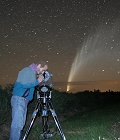
|
Ashley
Marles,
Old West Coast Road, Waddington Canterbury, New Zealand
Jan. 24, 2007 |
#1 |
Comet
McNaught put on a spectacular display for southern observers,
the photograper made this this self portrait by firing off
the camera flash at the beginning of the long exposure.
Photo
details: Canon
20D, 18mm
lens, f4, 180sec, 1600iso unguided camera on a tripod
|
|

|
Wayne
England,
Near Myponga reservoir, South of Adelaide, South Australia.
Jan. 25, 2007 |
#1,
#2, #3,
#4, |
The
nearby grazing kangaroos wondered what I was doing! Picures
#1 & #2 show what I presume is the Space Station rising
up from the horizon.
Photo
details: Canon EOS 50, 28-80mm lens, 1600ASA film
with exposures from 1 - 5 minutes. |
|
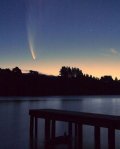
|
Dan
Macmillan,
lake Karapiro. Waikato, New Zealand
Jan. 18, 2007 |
#1,
more |
Photo
details: Nikon
D200, 28mm
lens, iso800, 30s, cs2 adjusted raw |
|
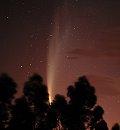
|
Brenda
Anderson,
Masterton, Wairarapa, New Zealand
Jan. 24, 2007 |
#1 |
The
orange glow is, we think, because of the lights from our
town in the distance.
Photo
details: 30 second exposure, Sony
A100 dSLR, 50mm
lens, f/1.7 |
|

|
Karim
Sahai,
Houghton Bay, Wellington, New Zealand
Jan. 27, 2007 |
#1,
#2, more |
The
comet was very easy to spot and photograph on one of the
rare cloudless nights in Wellington.
Photo
details:
(#1)
Canon
1DsII, ISO 1250, 28mm
lens, f/5.6, 25sec
(#2)
Canon
1DsII, ISO 1250, 200mm
lens, f/1.8, 2.5sec |
|
|
|